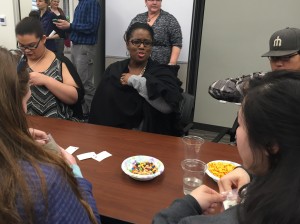
For more than a decade, the Color of Justice program has tried to educate students of color about legal professions and how they can give back to their communities by pursuing law. This year, for the first time, Alaska Native Corporations have come together to get rural students involved.
Judge Pamela Washington sits in a crowded room surrounded by youth who pepper her with questions about why she went into law.
She says she was thinking about graduate school when “My employer said, ‘You should go to law school.’ It was the first time I had even heard of it. I didn’t know any lawyers. I didn’t have any lawyers in my family. I hadn’t watched any law shows. And he said, ‘You should go to law school, and I said, ‘Okay.’”
Washington, who is now an Anchorage District Court Judge, is participating in MentorJet. It’s like speed dating for high schoolers to learn about jobs in the justice system. She tells the students she wanted to help people who were in need, and becoming a lawyer was a way to do that. That’s also why she participates in the Color of Justice program.
“Justice is not just done; justice is seen,” she says. “I think when people go into the courtroom, and they see people that represent the face of our community, I think (they) feel justice can be had there. Sometimes people leave the court system and they don’t feel that way because it’s not reflective of our community.”
Though the program has reached out to urban Alaskans for 13 years, it hasn’t included youth from rural communities. Bruce Anders, a vice president at Cook Inlet Region, Inc., decided to change that.
“I was concerned and found it a little ironic that a program that was promoting diversity in the legal profession lacked diversity with respect to Alaska Natives and rural Alaska students,” Anders says.
He worked with the other 11 regional Native corporations to fund 40 students from rural Alaska to travel to Anchorage and participate in the program. They traveled from villages as far as Akutan and Kaktovik.
Anders says if young adults from rural areas learn about the legal system, they can return to their communities and effect change through the Legislature, the justice system and their Native corporations.
That’s why 10th-grader Sam Schimmen from Gambell is participating in the program.
“I feel like the views and values of rural Alaskans are not very well portrayed in the justice system in general,” Schimmen says.
He says part of the problem is places like Gambell, which is located on St. Lawrence Island, are physically disconnected from the justice system and people can’t fully engage with it.
“There’s not really any lawyers there. There’s a phone court. You call in and FaceTime a judge, you FaceTime a jury, and that’s their court,” Schimmen says. “If you get in trouble, someone flies in from Nome, picks you up (and) brings you out.”
Schimmen says he wants to give rural people a voice in the justice system and help them understand how it works. He also wants to influence legislation by teaching urban Alaskans about the impacts of climate change and dumping in the ocean.
The two-day Color of Justice program teaches students about ways they can do those things through legal professions. It was founded by the National Association of Women Judges.
